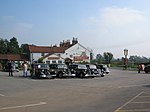Low Catton

Low Catton is a village and former civil parish, now in the parish of Catton, in the East Riding of Yorkshire, England. It is situated approximately 7 miles (11 km) north-west of the market town of Pocklington and about 1 mile (1.6 km) south of the village of Stamford Bridge. In 1931 the parish had a population of 85. Low Catton became a civil parish in 1866, on 1 April 1935 the parish was abolished and merged with High Catton to form "Catton".Low Catton lies on the east bank of the River Derwent. The church, dedicated to All Saints, was designated a Grade I listed building in 1967 and is now recorded in the National Heritage List for England, maintained by Historic England. In 1823, Low Catton church was under the patronage of the Earl of Egremont. In the village existed a grammar school with schoolmaster. The population at the time was 177. Occupations included nine farmers, a joiner, a shoemaker, and a curate. There was a yeoman, and the steward to Lord Egremont at Catton Lodge.
Excerpt from the Wikipedia article Low Catton (License: CC BY-SA 3.0, Authors, Images).Low Catton
Main Street, York Catton
Geographical coordinates (GPS) Address Nearby Places Show on map
Geographical coordinates (GPS)
| Latitude | Longitude |
|---|---|
| N 53.975195 ° | E -0.926389 ° |
Address
Low Catton Village Hall (Catton Village Hall)
Main Street
YO41 1EA York, Catton
England, United Kingdom
Open on Google Maps











